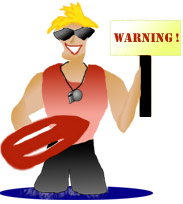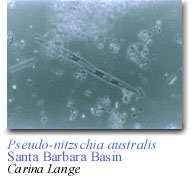![]() eadly
Diatoms
eadly
Diatoms
 In
September of 1991, a large number of pelicans and cormorants died mysteriously
in Monterey Bay, California. At first scientists were mystified, but through
careful investigation and use of the scientific method, the cause of death
was traced to a diatom species of the genus Pseudo-nitzschia. Scientists
discovered that the birds had been poisoned by the toxin by eating anchovies
that had eaten Pseudo-nitzschia australis.
In
September of 1991, a large number of pelicans and cormorants died mysteriously
in Monterey Bay, California. At first scientists were mystified, but through
careful investigation and use of the scientific method, the cause of death
was traced to a diatom species of the genus Pseudo-nitzschia. Scientists
discovered that the birds had been poisoned by the toxin by eating anchovies
that had eaten Pseudo-nitzschia australis.
The toxin is domoic acid, which several species of Pseudo-nitzschia were found to synthesize. Domoic acid has been found in fish and shellfish off both coasts of North America, posing a threat to people who consume contaminated seafood. Both shellfish and fish can accumulate domoic acid without apparent ill reactions; however, humans and certain other organisms cannot escape its effects. Domoic acid poisoning, or the human illness amnesic shellfish poisoning (ASP) takes place within fifteen minutes to twenty-four hours after consumption. Among the most common symptoms of ASP, are nausea, vomiting, and abdominal cramps, but in more severe cases, effects on humans include confusion, disorientation, permanent short-term memory loss, seizures, breathing difficulties, and even death.
 In
the 1991 outbreak, quick action by state health departments along the
west coast of the United States prevented human illnesses by closing both
recreational and commercial shell-fisheries. Domoic acid can cause large
losses in commercial and recreational species, affecting fisheries and
the economy. In the spring of 1999, the recreational razor clam season
off Washington State was postponed indefinitely due to elevated levels
of domoic acid in razor clams. Due to careful monitoring and appropriate
action, very few individuals have died from ASP in North America; however,
toxic phytoplankton, including those that produce domoic acid, kill 10
times more people worldwide than sharks!
In
the 1991 outbreak, quick action by state health departments along the
west coast of the United States prevented human illnesses by closing both
recreational and commercial shell-fisheries. Domoic acid can cause large
losses in commercial and recreational species, affecting fisheries and
the economy. In the spring of 1999, the recreational razor clam season
off Washington State was postponed indefinitely due to elevated levels
of domoic acid in razor clams. Due to careful monitoring and appropriate
action, very few individuals have died from ASP in North America; however,
toxic phytoplankton, including those that produce domoic acid, kill 10
times more people worldwide than sharks!
 Although
species that produce domoic acid may be abundant in waters of the California
Current System, these organisms do not always produce the neurotoxin,
and are thus not always harmful. Researchers are working to predict when
an organism is likely to produce the toxin that poses a health risk and
when it might bloom. Since organisms respond to environmental changes,
there may be certain conditions that cause this undesirable response.
Solutions will continue to be developed by finding out more about the
relationships between environmental conditions and the organisms with
whom we share our world.
Although
species that produce domoic acid may be abundant in waters of the California
Current System, these organisms do not always produce the neurotoxin,
and are thus not always harmful. Researchers are working to predict when
an organism is likely to produce the toxin that poses a health risk and
when it might bloom. Since organisms respond to environmental changes,
there may be certain conditions that cause this undesirable response.
Solutions will continue to be developed by finding out more about the
relationships between environmental conditions and the organisms with
whom we share our world.
How do YOU know when diatoms have decided to produce domoic acid? It's
important to read all posted signs at the beach regarding the presence
of domoic acid in shellfish. In California, the Department of Health Services
monitors the situation; you can contact them at the Shellfish Information
Line at:
1-800-553-4133.
Informative sites: 
Washington Department of Fish and Wildlife - Razor Clams - Domoic Acid
http://www.wa.gov/wdfw/fish/shelfish/razorclm/domacid.htm
NOAA Northwest Fisheries Science Center - Marine Biotoxins and Harmful
Algal Blooms
http://research.nwfsc.noaa.gov/hab/biotoxins.htm#domoic